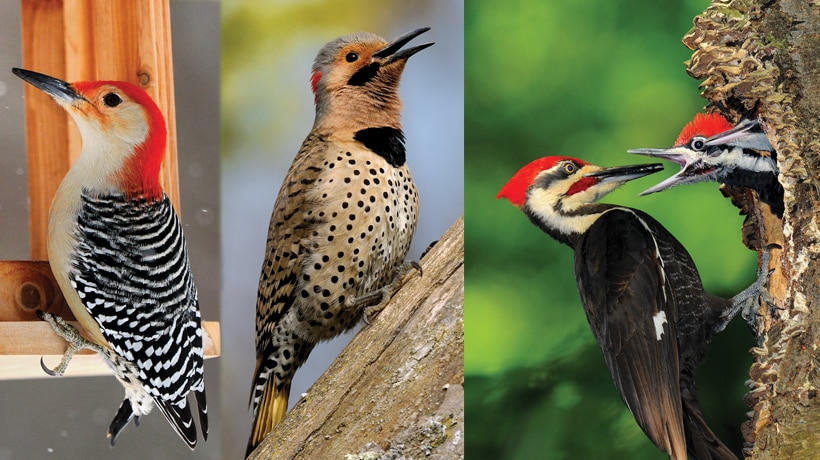Woodpeckers in Florida: Recognition Tips and Habitat Preferences
Woodpeckers in Florida: Recognition Tips and Habitat Preferences
Blog Article
Introducing the Secrets of Woodpeckers: Habits, Environment, and More
Woodpeckers, with their special actions and specialized adaptations, have actually long attracted scientists and nature lovers alike. These impressive birds have a range of appealing keys that clarified their survival techniques, habitat choices, and detailed interaction methods. By uncovering the secrets bordering woodpeckers' actions and environment selections, a deeper understanding of these avian wonders emerges, providing a look right into their remarkable globe. What makes these birds genuinely phenomenal, and just how do they browse their setting with such accuracy and ability? Allow's discover the exciting world of woodpeckers and unwind the enigmatic information that make them such fascinating topics of research study.
Woodpecker Actions Insights
In taking a look at woodpecker behavior, a remarkable screen of specialized abilities and adaptations arises, shedding light on their impressive environmental particular niche. Woodpeckers, understood for their distinct drumming on trees, possess a selection of behavioral qualities that contribute to their survival and success in their atmosphere.
Furthermore, woodpeckers display an unique feeding habits identified by their ability to essence insects from tree bark using their specialized beaks. Their lengthy, barbed tongues aid in catching target, while their strong neck muscle mass give stability and accuracy throughout pecking motions. This feeding method allows woodpeckers to accessibility hidden insect larvae and extract them with impressive efficiency.
Habitat Preferences and Choice
What variables influence the habitat choices and option of woodpeckers? Woodpeckers are very adaptable birds known to live in numerous settings worldwide. However, they do show choices for sure environment characteristics. One essential element affecting woodpecker environment option is the schedule of ideal nesting websites. Woodpeckers generally choose forests with a mix of mature trees that supply adequate possibilities for dental caries excavation. These dental caries function as crucial nesting and roosting sites for woodpeckers and are essential for their breeding success.
Additionally, woodpeckers show a choice for environments with a plentiful supply of food sources. They are primarily insectivorous, feeding on beetles, ants, larvae, and various other bugs discovered in decaying timber or tree bark. Consequently, woodpeckers have a tendency to favor wooded locations with a diverse insect population to fulfill their nutritional needs.
Moreover, the visibility of dead or rotting trees is another vital consider woodpecker habitat option. These trees not more information only provide food resources but additionally use suitable substratum for cavity excavation. Dead trees are essential for the upkeep of healthy woodpecker populaces, as they play a vital duty in the woodpeckers' life cycle and ecological community characteristics.
Feeding Habits and Diet Regimen Composition
Woodpeckers show a specialized feeding behavior concentrated on foraging for insects within numerous habitats. Their diet plan primarily contains insects such as beetles, ants, caterpillars, and spiders, which they situate by tapping on tree bark and paying attention for the sound of motion inside. Woodpeckers utilize their strong beaks to pierce right into the wood and their lengthy, barbed tongues to remove victim from holes. In addition to bugs, woodpeckers additionally consume tree sap, fruits, nuts, and seeds, adding selection to their diet depending upon the period and availability of food sources.
The foraging strategies of woodpeckers are well-adapted to their arboreal way of living. Woodpeckers play a vital function in preserving the health of woodlands by managing insect populations and aiding in the disintegration of timber.
Drumming Seems and Communication
Making use of fast drumming sounds on numerous surface areas, woodpeckers employ a distinct type of communication to signify area boundaries and bring in companions. This drumming behavior is not just a way of communication yet also works as a means for woodpeckers to develop their visibility within a specific location. The intensity, speed, and he said pattern of the drumming can share important information to other woodpeckers around.
Woodpeckers make use of drumming sounds to reveal their existence in an area and to warn off potential burglars. The loud and recurring nature of the drumming serves as a clear signal to other woodpeckers that the location is already declared. This helps in minimizing conflicts and lessening physical confrontations in between people.

Survival Adaptations and Specialized Composition
/https://tf-cmsv2-smithsonianmag-media.s3.amazonaws.com/filer_public/30/ac/30acf469-09cd-4fcc-a812-1aa30f477578/aprmay2024_l09_woodpeckers.jpg)
Final Thought
In final thought, woodpeckers exhibit unique actions, such as drumming noises for communication, and have specialized makeup for survival have a peek at this site in their selected habitats. Their feeding behaviors and diet regimen structure further show their versatility to various environments. By recognizing these elements of woodpeckers, scientists and preservationists can much better protect and maintain these interesting birds and their communities.
Report this page